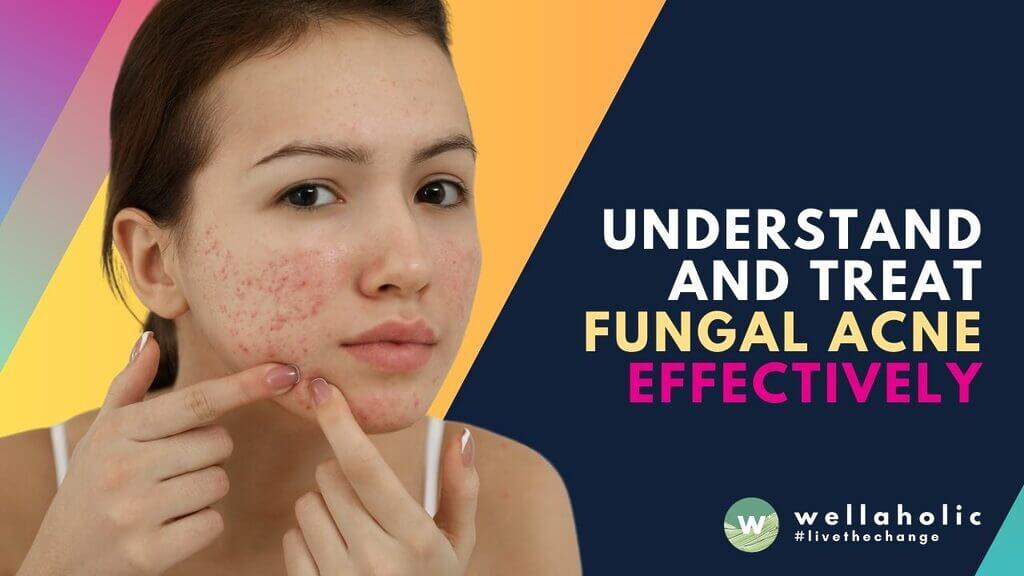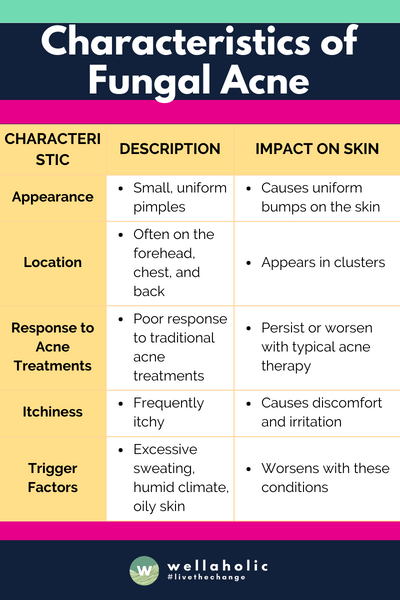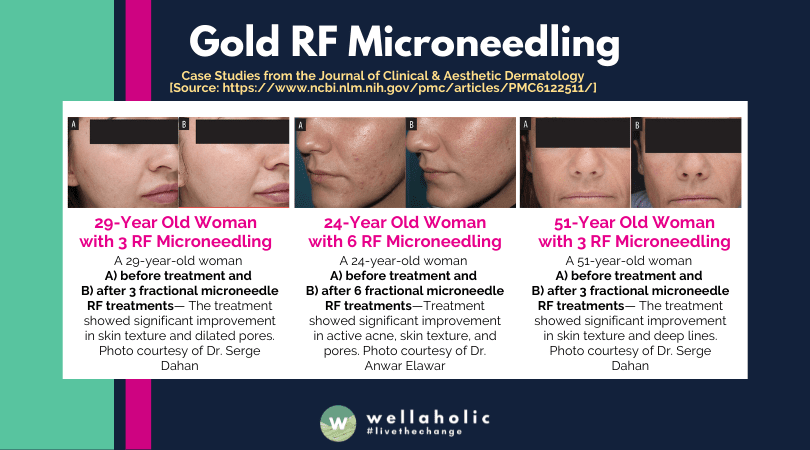
Understanding and Treating Fungal Acne Effectively
Beyond the Surface: Innovative Treatments for Fungal Acne Revealed
- Fungal acne confusion: Caused by yeast overgrowth, often mistaken for regular acne.
- Climate impact: Singapore’s humid weather exacerbates fungal acne conditions.
- Identifying characteristics: Uniform small bumps, itchy, resistant to conventional acne treatments.
- Lifestyle factors: Excessive sweating and tight clothing create ideal environment for yeast.
- Treatment approach: Gold RF Microneedling effective for fungal acne and skin rejuvenation.
- Prevention strategies: Balanced skincare, breathable fabrics, and regular skin assessments crucial.

Introduction
As an Aesthetic Director with over a decade in the aesthetics industry, I’ve seen various skin concerns. One that often confuses clients is fungal acne. It’s not your typical acne. In my experience, many mistake it for regular acne. But it’s different. Fungal acne is caused by an overgrowth of yeast, a type of fungus. This particular yeast is present on the skin of every individual. But sometimes, it grows too much. This can cause small, itchy, acne-like breakouts.
In the article I’m writing, I’ll explain more about fungal acne. I’ll talk about what causes it and how to tell it apart from other types of acne.

What Exactly is Fungal Acne?
I’ve seen many clients in Singapore struggle with fungal acne, or Malassezia folliculitis. This condition, caused by yeast overgrowth, is tricky because it looks like regular acne but behaves differently. It presents as uniform small bumps and often comes with an itch, a clear sign that it’s not your typical bacterial acne.
Dealing with fungal acne requires a different approach. Given Singapore’s humid climate, it’s a frequent issue here. I advise my clients to keep their skin dry and clean, and to use products specifically formulated to target yeast overgrowth. This targeted approach, combined with lifestyle adjustments, can effectively manage this unique skin concern.
Causes of Fungal Acne
As founders of Wellaholic, we’ve seen many customers struggle with fungal acne. This skin condition often gets mistaken for regular acne, but it’s quite different. Fungal acne isn’t really acne at all. It’s an infection of the hair follicles caused by an overgrowth of yeast.
We’ve noticed that several factors can lead to fungal acne. Hot, humid climates like Singapore’s can make it worse. Tight, non-breathable clothing and excessive sweating are also common culprits. Some medications, especially antibiotics, can disrupt the skin’s natural balance and trigger fungal acne. At Wellaholic, we always stress the importance of proper skincare routines to our customers. Using the right products can help prevent this pesky condition.

Identifying Fungal Acne
In my years in the aesthetics industry, I’ve seen many cases of fungal acne misdiagnosed as bacterial acne. This misstep is common due to their similar appearance. However, fungal acne typically presents with persistent itchiness and uniformly sized pimples. Another telltale sign is its resistance to conventional acne treatments, which often exacerbates the condition.
Understanding the nuances of fungal acne is crucial. It thrives in moist environments and can be triggered by an imbalance in the skin’s microbiome. Unlike bacterial acne, it doesn’t respond well to standard acne medications, requiring antifungal treatments instead. As a professional, it’s vital to distinguish between these types to provide effective care.

The Role of Climate and Lifestyle
In Singapore’s hot and humid climate, I often see clients battling fungal acne, a condition exacerbated by our weather. Excessive sweating and tight clothing create an ideal environment for yeast overgrowth on the skin, leading to this unique form of acne. Awareness of these factors is key to managing the condition.
Through my experience, I’ve learned that heavy skincare products can worsen fungal acne. It’s essential to opt for lightweight, non-comedogenic options. Personalized skincare routines, considering our climate and lifestyle, play a crucial role in both treating and preventing fungal acne effectively.

Effective Treatment Strategies
In my aesthetic practice, I’ve seen remarkable results with Gold RF Microneedling, especially for clients battling fungal acne. This innovative technique combines microneedling with radiofrequency energy, creating a unique approach that addresses the deep-seated issues causing fungal acne. What’s impressive is how it not only targets the acne but also stimulates collagen production, improving overall skin texture.
Nevertheless, it is important to have a specialist do the treatment, as the process could spread infection and worsen the breakout.
Gold RF Microneedling stands out for its precision and effectiveness in treating fungal acne. My clients often express satisfaction with the reduced inflammation and clearer skin post-treatment. This method, by penetrating the skin’s deeper layers, helps in controlling the fungal activity, offering a dual benefit of acne treatment and skin rejuvenation.

Preventing Fungal Acne
At Wellaholic, we’ve seen our fair share of customers struggling with fungal acne, also known as pityrosporum folliculitis. This pesky condition often mimics regular acne but requires a different approach to treatment and prevention. As someone who has dealt with fungal acne myself, I understand the frustration and self-consciousness it can cause.
To prevent fungal acne, we recommend focusing on a few key areas. First, keep your skin clean and dry, as the fungus thrives in warm, humid environments. After workouts or sweating, be sure to shower and change out of damp clothes promptly. Second, choose skincare and makeup products that are non-comedogenic and avoid heavy, occlusive ingredients like coconut oil or petrolatum. Look for products containing salicylic acid, tea tree oil, or niacinamide, which can help control the growth of the fungus.
Finally, consider making some lifestyle changes to support your skin health from the inside out. Eating a balanced diet rich in antioxidants and probiotics can help boost your skin’s natural defenses against fungal overgrowth. Managing stress through practices like meditation or yoga can also be beneficial, as stress can weaken your immune system and make you more susceptible to skin issues. Remember, consistency is key when it comes to preventing fungal acne. By incorporating these tips into your daily routine, you can help keep your skin clear, healthy, and glowing.

Conclusion
In summary, treating fungal acne starts with changing your skin care routine. Use products that don’t feed the yeast. I recommend anti-fungal creams and shampoos. Sometimes, oral medication is needed. It’s important to keep your skin dry and clean. Tight, sweaty clothes can make it worse. If you think you have fungal acne, see a skin expert. They can give you the right treatment.
Frequently Asked Questions (FAQ)
Q: What is the cause of fungal acne on the face?
A: Fungal acne, or Malassezia folliculitis, is a skin condition caused by an overgrowth of yeast (a type of fungus) that live on the skin. Factors that can promote the growth of fungal include warm, humid environments, weakened immune systems, misuse or overuse of antibiotics, cosmetic products that trap heat and sweat on the skin, or an unhealthy diet.
Q: What are the symptoms of fungal acne and how is fungal acne diagnosed?
A: Symptoms of fungal acne can include small, uniform red bumps and pustules, itching or irritation of the bumps, location of bumps often on the chest, back, and forehead, and lack of response to traditional acne treatments. To diagnose fungal acne, dermatologists often look for these symptoms and may also take a skin scraping to study under a microscope or a yeast culture to confirm the diagnosis.
Q: How does fungal acne differ from regular acne vulgaris?
A: Fungal acne, or folliculitis, and regular acne vulgaris, or bacterial acne, though look similar, are fundamentally different. Fungal acne is caused by the overgrowth of yeast, whereas bacterial acne is typically caused by bacteria. Unlike bacterial acne, fungal acne can be itchy and is often uniform in appearance, with pimples the same size distributed across the affected area. It’s frequently mistaken for regular acne, thus it doesn’t respond well to typical acne treatments.
Q: How can I know if I have fungal acne?
A: If you have acne-like breakouts that haven’t improved with standard treatments such as benzoyl peroxide and retinoids, you might have fungal acne. Generally, fungal acne tends to appear as uniform small bumps or pustules on the back, chest, or forehead. The skin condition may cause an itchy sensation – this is not common with regular acne vulgaris. Yet, to get the correct diagnosis, consult a dermatologist or a skin specialist.
Q: What is the best treatment for fungal acne?
A: Treatment for fungal acne typically involves reducing yeast growth on the skin. Topical treatments such as antifungal creams, gels, and foams are commonly used. In severe cases, oral antifungal medications may also be used. Use skincare products that don’t promote yeast growth. Developing a skincare routine that includes gentle, non-oily cleansers, oil-free moisturizers and avoiding products that can trap heat and moisture can help as well.
Q: How does diet influence the development of fungal acne?
A: Diet might influence the balance of bacteria in your gut, which can affect the yeast on your skin. Consuming a lot of high-sugar and high-carb foods can cause an overgrowth of yeast, possibly leading to fungal acne. While more research is needed, a balanced diet rich in natural, nutrient-dense foods can contribute to overall good health, which might help prevent fungal acne.
Q: Can improper skincare routine cause fungal acne?
A: Improper skincare routines can indeed contribute to the development of fungal acne. For instance, using heavy, oily skin care products or not replacing sweat-soaked workout clothes promptly can create a conducive environment for yeast to flourish. Therefore, maintaining good personal hygiene such as regularly washing and exfoliating your skin, using non-comedogenic products, and changing out of sweaty clothing can help to reduce the likelihood of developing fungal acne.
Q: Can changes in hygiene habits help manage fungal acne?
A: Absolutely. Proper hygiene habits are essential to managing and preventing fungal acne. This can include washing your face twice daily with a gentle, oil-free cleanser, regularly changing and washing your bedsheets, avoiding heavy, greasy skincare products, and removing sweaty clothes promptly. These practices can help prevent an environment where yeast can overgrow.

Serene Chiam, Aesthetic Director (LinkedIn)
Serene Chiam serves as the Aesthetic Director at Wellaholic, leveraging her decade-long experience in the aesthetics industry. Previously a Clinical Aesthetics Manager with Laser Clinics Australia, Serene holds a CIDESCO certificate in skincare and a Bachelor of Health Science (Aesthetics) from Torrens University of Australia. Her deep understanding of RF microneedling, collagen induction therapy, and skin tightening treatments ensures that Wellaholic’s clients receive the most effective and personalized care for their aesthetic concerns.
Contact Serene at [email protected]
GET IN TOUCH
Book Now Pay Later

Gold RF Microneedling Facial
- ⭐ Uses Up to 64 Micro Needles. Gold RF Microneedling: Ultimate anti-aging treatment with 64 needles to penetrate the skin, release RF energy, and trigger collagen and elastin production for a clearer complexion and firmer skin
- ⭐ Safe and Minimally Invasive. Gold RF Microneedling is a safe, minimally invasive.
- ⭐ Effectively Treats Acne Scars, Pigmentation & Wrinkles. Extremely effective aesthetic treatment for treating acne scars, pigmentation, fine lines and wrinkles.
- ⭐ Stimulates Collagen Growth. Gold RF Microneedling stimulates collagen and elastin for new, youthful-looking skin.
- ⭐ Award-Winning. Wellaholic’s treatments have been recognized by top beauty publications such as Daily Vanity, Beauty Insider, and Tropika Club Magazine.
- ⭐ Over 2000 Verified Customer Reviews. Wellaholic has over 30 industry awards and over 2000 positive reviews from customers, and >50% are repeat customers.







